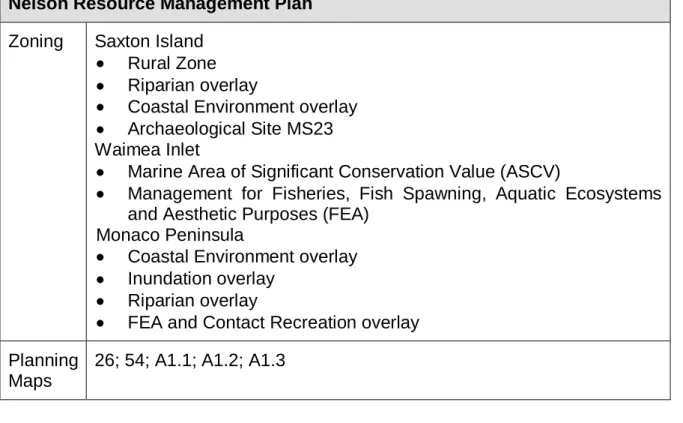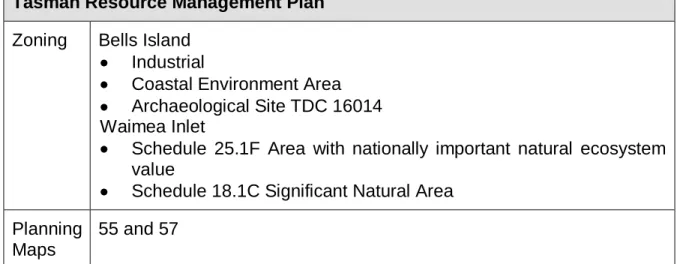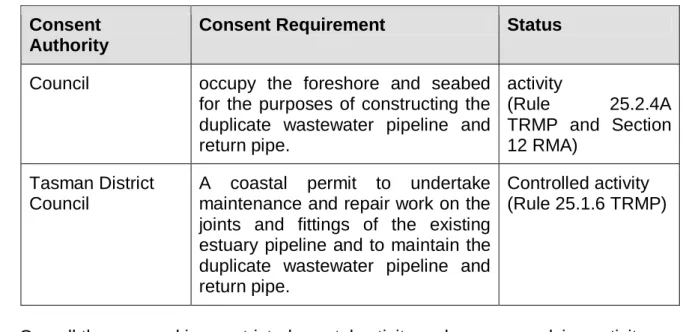Report and decision of Nelson City and Tasman District Councils through a panel of independent commissioners. RM090563 Coastal permit for disturbance of foreshore and bottom of an estuary over a distance of more than 1,000 metres. RM095331 Coastal permit for construction of two pipelines (duplicated sewage pipeline and return pipe) below the bund of the Waimea Inlet.
RM095334 Coastal permit to disturb the shore and bed of an estuary for a distance of more than 1000 metres. The pipeline will be located between 5 and 20 meters south of the existing pipeline. A coastal permit for the construction of two pipelines (dual sewage pipeline and return pipeline) under the Waimea Inlet bed.
Coastal Permit for breaching the shore and bed of an estuary over a distance of more than 1000 metres. Coastal Permit for breaching the shore and bed of an estuary over a distance of more than 1000 metres.

Council’s Consultant Reporting Officer’s Report and Evidence Mr Steve Wilkes
Mr. Melville described the birds as using the shell bank as a refuge during high tides. Mr Melville said the clam embankment was used for up to three hours on either side of the tide and the area should be avoided during that time. Mr Melville contributed to the proposed bird monitoring conditions proposed by the applicant.
Commissioner de Hamel asked if Mr. Melville thought the best way to observe birds was from inside a vehicle. Mr. Melville stated that it would be helpful if the applicant could provide a timeline of when the work would begin. Mr Melville agreed that contractors would require access to the site and would encourage them to use the southern entry points.
Applicant’s Right of Reply
Mr Melville said he was particularly concerned about helicopter use and that he was not aware of helicopters being mentioned in the initial application.
PROCEDURAL MATTERS
We then determined that applicants would have a short period to comment on the updated consolidated terms before the applicant would be required to provide their response.
PRINCIPAL ISSUES AND OUR MAIN FINDINGS
Therefore we accept his testimony; however, it was clear that it places significant value on three identified ecosystem units: sabellarid worm mounds, sponge gardens, and eelgrass beds. We are satisfied that, if the work is carried out carefully and the right conditions are created to ensure that restoration of the estuary surface is as careful as is practical, the productivity and integrity of these ecosystems will naturally be restored. e). To what extent will the proposed works have adverse effects on bird bleaching, bird feeding and energy expenditure, particularly of arctic migratory bird species present at Waimea Inlet?.
This issue is both the most controversial, and the most difficult to be certain about the success or failure of safeguards to protect birds from adverse effects. It is clear from the evidence presented that the greatest risk time is 2.5 to 3 hours either side of high tide, as this is when birds rest on the shell bank. The rest of the time the birds are spread over the estuary and if they are disturbed by the works, they will just move further away.
Seasonally, the greatest risk appears to be immediately after Arctic migrants arrive from the Northern Hemisphere and just before they leave at the end of the summer season. We do not see potential effects on birds as a reason to refuse consents; and this was not requested by the applicants. But we have some concerns that require restrictions on the exercise of consents to try to minimize the negative effects on birds as much as possible.
What is problematic is the great degree of uncertainty about what effect the work may have on the birds. People and vehicles on the estuary along the route of the pipeline must not actually disturb the birds on the shell bank. Overall, despite the lack of certain knowledge about the likely adverse effects on birds, we are satisfied that, with the appropriate conditions, the works can proceed with only a minimal level of disturbance occurring.
As per our findings in (e) above, we are satisfied that the disturbance of birds from the works has been adequately addressed and the risk of bird strike occurring as a result of the works is minimal.
RELEVANT STATUTORY PROVISIONS 1 Policy Statements and Plan Provisions
Part 2 Matters
Logically, if birds are not disturbed from the shell bank by the works, there should not be a problem with birds moving to the airport to roost, as Mr McDonald feared.
DECISION
REASONS FOR THE DECISION Effects on the Environment
The effects on the environment are discussed above as part of our main findings and overall we are satisfied that the effects on the environment are likely to be minor. Where the effects are uncertain, particularly with the effects on birds, we are satisfied that appropriate conditions can be put in place which will appropriately mitigate the potential effects to a minor level. The discussion of the aims and policies in the application and Mr Wilkes's report is extensive, and under section 113(3) we adopt section 9.5 of the application and section 7.2 of Mr Wilkes'.
We agree that the proposal, taking into account the conditions that have been imposed, will not be inconsistent with the objectives and policies set out in it. We accept and, pursuant to section 113(3), approve section 7.1 of Mr. Wilkes discussing and evaluating TRMP objectives and policies. For the avoidance of doubt, we also agree and approve his last paragraph in that section which refers to the need for improvement.
Finally, Goal 21.3.0 and Policy 21.3.1 aim to preserve the natural character and landscape of the marine coastal area, and to allow for structures or physical modifications where the impact on natural components of the landscape and seascape is limited and consistent with the existing degree of modification. We are convinced that the application and the conditions imposed will ensure that this policy and the objective are not compromised. Pursuant to Article 113, third paragraph, we adopt that assessment in principle, but we believe that the conditions we set are necessary for this.
Mr Wilkes provided a very comprehensive list of Section 6 and 7 issues that he saw as important. We are particularly aware and aware of the perspective that Tiakina Te Taiao brought to the hearing. We are aware that local iwi greatly value access and have historically used it for many common activities.
Taking a broad overall judgment approach to the purpose of the Act, we are satisfied that the proposal is consistent with Part 2 and achieves sustainable management of natural and physical resources as set out in Section 5 of the Act.
COMMENTARY ON CONDITIONS OF CONSENT
The consent holder must ensure that all contractors carrying out the work are made aware of the conditions of these resource permits and must ensure compliance with all conditions. At least two days before the works authorized under this consent commence, the consent holder must inform both Tasman District Council's Coordinator Compliance Monitoring and Nelson City Council's Monitoring Officer of the representative's name and how they can be contacted during the period of work. A restoration plan outlining the methods and procedures to be implemented to restore and rehabilitate all construction areas (including replanting where applicable) to a stable condition similar to that which existed prior to commencement of work.
Disturbance of the estuary bed is limited to the smallest possible area. Bells Island has been properly restored (according to the Council's Compliance Monitoring Coordinator) following the completion of the works. The spread of Wilsonia backhausei as a result of activities permitted by these consents must be avoided or minimized as much as possible.
The consent holder keeps written records of the approach to the ecologist/biologist and his recommendations in this regard and of the work performed. Prior to any excavation or disturbance in the sabelarid mound areas, earthworm mounds should be disturbed as little as possible with an excavator to the location in the immediate vicinity. After the works are completed, the augers are moved back and, as far as practicable, are re-established on the demolished pipeline corridor.
The consenting party shall ensure that the location is left in a finished and orderly condition after the completion of the works. They are used wherever practicable to avoid disturbance to other parts of the estuary. Plantings are carried out in one growing year after the completion of the works and are maintained for two years.
Access to the property by councils or their officers or agents is reserved under section 332 of the Act. The consent holder must comply with the Councils requirements in relation to all building and health regulations, regulations and acts. Original plans and copies of Council standards and documents referred to in the consents are available for inspection at Nelson City Council and the Tasman District Council office in Richmond.
During the works, no pollutants (except sediment generated on site) may be discharged or discharged onto the land or water of the estuary. Work can resume with the written approval of the councils and the New Zealand Historic Places Trust.

